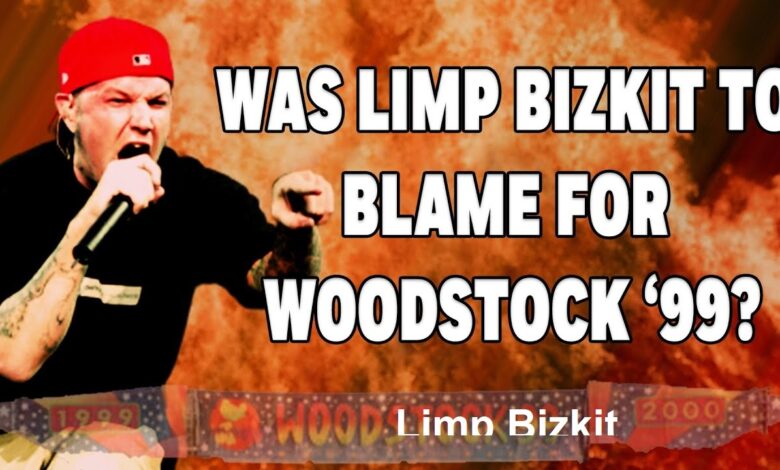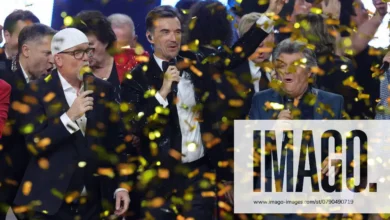Limp Bizkit Woodstock 99 – The Performance That Shook an Entire Generation

1. Limp Bizkit Woodstock 99: The Performance Everyone Still Talks About
When people mention Limp Bizkit Woodstock 99, there’s usually a mix of fascination and chaos in the air. It wasn’t just another rock performance — it became a cultural turning point, symbolizing both the power and the danger of raw musical energy. Limp Bizkit, led by frontman Fred Durst, took the stage at a festival already simmering with tension, and what unfolded that night is still one of the most talked-about moments in rock history.
The late 1990s were a unique time for music. Nu-metal was dominating the charts, and Limp Bizkit stood at the center of that storm. Their performance at Woodstock 99 captured that aggressive, rebellious energy perfectly — maybe too perfectly. Thousands of fans screamed, moshed, and raged in the crowd as the band unleashed a set that would go down in infamy.
More than two decades later, Limp Bizkit Woodstock 99 remains a symbol of the era’s chaos — a performance that walked the fine line between musical liberation and pure destruction. It wasn’t just a concert; it was a cultural moment that exposed the intensity, frustration, and rebellion of an entire generation.
2. The Context: A Festival Meant to Celebrate Peace and Love

Limp Bizkit Woodstock 99 was supposed to be a modern tribute to the original 1969 festival — the iconic event known for peace, love, and unity. But by the time Limp Bizkit hit the stage, that peaceful vibe had vanished. The heat was brutal, the prices were outrageous, and the crowd was angry. Add a few hundred thousand people and a lot of alcohol, and you had a recipe for disaster.
The organizers envisioned Woodstock 99 as a massive celebration of late-90s culture, featuring artists like Metallica, Korn, Rage Against the Machine, and, of course, Limp Bizkit. However, what they got instead was an event spiraling out of control. From poor sanitation to aggressive security, everything seemed to fuel the chaos.
By the time Limp Bizkit Woodstock 99 began, the tension was palpable. Fans were ready to explode — and Fred Durst, known for his provocative stage presence, was more than willing to light the fuse. The band’s heavy riffs and confrontational lyrics matched the mood perfectly, for better or worse.
3. Fred Durst and the Spark That Ignited the Crowd
When Fred Durst stepped on stage at Limp Bizkit Woodstock 99, he wasn’t just performing — he was channeling the collective rage of thousands of young fans. Dressed in his trademark red cap and exuding attitude, Durst commanded the crowd with his signature mix of charisma and aggression.
As the band launched into hits like Break Stuff and Nookie, the audience erupted. What was meant to be energetic crowd participation quickly escalated into something uncontrollable. People started tearing apart plywood, crowd-surfing on debris, and letting out pent-up frustration in a way that shocked even seasoned festival-goers.
Durst famously told the crowd, “Don’t hurt anybody — but I don’t think you should mellow out either.” That single line summed up the duality of the moment. Limp Bizkit didn’t cause the chaos alone, but their performance became the spark that set off an already unstable situation. Limp Bizkit Woodstock 99 would forever be remembered for that explosive, unpredictable energy.
4. The Music: Raw Energy and Controlled Chaos
Musically, Limp Bizkit Woodstock 99 was exactly what fans wanted — heavy, raw, and unapologetically aggressive. The band’s fusion of rap, metal, and punk energy resonated with the youth of that time. Songs like Break Stuff, Nookie, and Re-Arranged weren’t just tracks; they were anthems of rebellion, frustration, and identity.
Wes Borland’s distinctive guitar tones sliced through the night air, while DJ Lethal’s turntable effects added an electrifying edge. Sam Rivers’ basslines and John Otto’s pounding drums created an atmosphere that was both thrilling and dangerous. It was nu-metal at its loudest and most confrontational.
Even though the sound system struggled under the sheer intensity, the crowd didn’t care. The performance was raw and imperfect — but that’s what made Limp Bizkit Woodstock 99 unforgettable. It was pure, unfiltered energy that perfectly embodied the reckless spirit of late-90s youth culture.
5. The Aftermath: Chaos, Blame, and Broken Dreams
As the night went on, things spiraled out of control. Parts of the crowd became violent, with reports of vandalism, fires, and even assaults. The festival grounds were left in ruins, and by the end of the weekend, Woodstock 99 was being called one of the biggest disasters in music history.
Limp Bizkit faced intense backlash for their role in the chaos. Critics accused Fred Durst of encouraging violence, while others argued that the festival organizers were to blame for poor planning and lack of security. Durst defended the band, saying they were simply feeding off the energy of the crowd — something every live performer does.
In reality, the Limp Bizkit Woodstock 99 incident was the result of multiple failures. The crowd’s frustration over the oppressive heat and expensive amenities mixed with the band’s aggressive energy, creating a volatile atmosphere. It became clear that this wasn’t just about one performance — it was a reflection of a generation’s disillusionment.
6. Media Reaction: The Villainization of Limp Bizkit
Following the event, the media went into overdrive. Headlines painted Limp Bizkit as the villains of Woodstock 99, accusing them of inciting a riot. TV networks replayed footage of fans destroying the venue while Fred Durst screamed into the microphone, creating a narrative that the band had lost control.
However, many who were there argued that Limp Bizkit were unfairly blamed. Other performances throughout the weekend also contributed to the overall chaos, and the festival’s infrastructure was already failing long before their set. Still, Limp Bizkit Woodstock 99 became the focal point of the controversy — the face of everything that went wrong.
The band’s reputation took a hit, but in the long run, it also cemented their place in rock history. The event became part of their legend — proof of their ability to provoke, energize, and connect with audiences in a way few others could. Even today, that performance remains a defining chapter in Limp Bizkit’s story.
7. The Cultural Impact: A Generation’s Frustration on Display
To truly understand Limp Bizkit Woodstock 99, you have to understand the cultural backdrop of the late 1990s. It was a time of pent-up anger, rebellion, and a sense of alienation among young people. Music became an outlet for emotions that mainstream society didn’t want to acknowledge.
Limp Bizkit’s sound — aggressive, loud, and unapologetically raw — resonated with that generation. Their Woodstock performance was more than a concert; it was an explosion of collective emotion. It reflected a generation’s frustration with authority, commercialization, and fake optimism.
Ironically, Woodstock 99 was supposed to be about peace and unity, but it ended up showcasing the opposite — a society on the edge. And while it’s easy to blame the band, the truth is that Limp Bizkit Woodstock 99 was just a mirror reflecting the cultural tensions of its time.
8. Revisiting Limp Bizkit Woodstock 99 Decades Later
In recent years, documentaries like Netflix’s Trainwreck: Woodstock ’99 have brought new attention to the infamous festival. Younger audiences, many of whom weren’t even alive in 1999, are now discovering the chaos and controversy surrounding Limp Bizkit Woodstock 99.
Interestingly, the band has embraced the legacy. Fred Durst often jokes about the event in interviews, acknowledging its madness but also recognizing its place in rock history. Limp Bizkit’s modern shows are more self-aware, with a playful energy that contrasts the unrestrained aggression of the past.
Today, many fans look back on Limp Bizkit Woodstock 99 not just as a disaster, but as a time capsule of a raw, unfiltered era in music. It represents both the power and danger of live performance — a reminder that when music connects too deeply, it can ignite emotions that no one can fully control.
9. The Legacy: What Limp Bizkit Woodstock 99 Means Today
More than 25 years later, the legacy of Limp Bizkit Woodstock 99 continues to echo through music culture. It stands as a cautionary tale about what happens when passion and aggression mix without boundaries. But it’s also a reminder of the incredible power of live music — its ability to unite, provoke, and stir emotions.
For Limp Bizkit, the event became a turning point. While the controversy hurt them temporarily, it also gave them a kind of mythic status. Few performances in rock history have been so talked about, analyzed, and remembered. Even now, fans and critics debate whether it was reckless or revolutionary.
Ultimately, Limp Bizkit Woodstock 99 symbolizes the chaos of an era that was both thrilling and turbulent. It was a moment when the walls between artist and audience completely disappeared — for better or worse.
10. Final Thoughts: The Day the Music Broke Loose
In the end, Limp Bizkit Woodstock 99 was more than just a concert gone wrong. It was an event that captured the energy, anger, and unpredictability of its time. While it will always carry a controversial legacy, it’s impossible to deny its importance in shaping the conversation around live performance and audience responsibility.
The chaos of that night has since become rock legend — both a warning and a celebration of how powerful music can be. Limp Bizkit didn’t just perform; they unleashed something primal that connected deeply with fans, even if it spiraled out of control.
So yes, Limp Bizkit Woodstock 99 was wild, messy, and unforgettable — exactly the kind of moment that keeps rock ‘n’ roll alive in the world’s collective memory.
